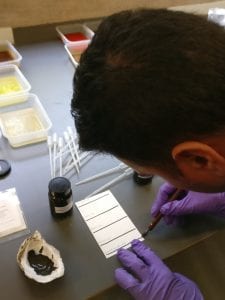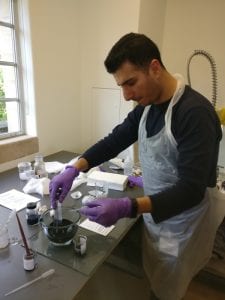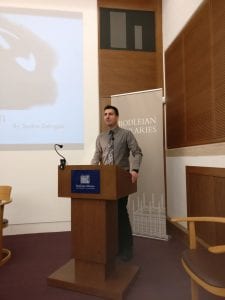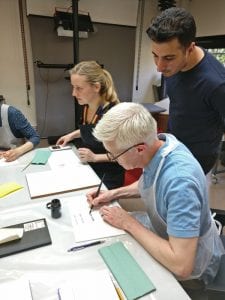
Reconstructing Knowledge: Sadra Zekrgoo’s Persian Ink PhD Project
Sadra Zekrgoo’s research focuses on the analysis and historical reconstruction of traditional Persian inks recipes from fifteenth- to eighteenth-century manuscripts, using innovative non-invasive photographic imaging methods to aid conservation decision making. In 2018 Sadra completed a PhD at the Grimwade Centre for Cultural Materials Conservation. He talked to Georgia Garvey-Hawke from the SHAPS Engagement team about how his passion for conservation has taken him around the world, and how studying at the Grimwade Centre has fostered a love of teaching.
What brought me to study cultural materials conservation? Well, first off, my mother is an art conservator, and my father is an art historian (laughs).
I have always been interested in art; I studied graphic design and animation in my Bachelor degree when I was in Malaysia but did not truly enjoy working in the field. I decided to apply for a conservation internship at the Islamic Art Museum of Malaysia. There I was able to experience different kinds of conservation including ceramic, metal, paper, and textile conservation. It was during a second internship at the National Archives of Malaysia I understood for a fact that I truly loved conservation.

If you are going to enter the conservation field, you have to be willing to travel, and you have to be prepared to undertake short-term contracts. After completing two internships in Malaysia, I went to England in 2010 to get my Master degree in Conservation of Fine Art at the University of Northumbria. Then, in 2013, my parents, Associate Professor Dr Mandana Barkeshli and Professor Dr Amir Zekrgoo, were invited by the Grimwade Centre for Cultural Materials Conservation to come to the University of Melbourne and investigate the Middle Eastern Manuscript Collection available at the Baillieu Library. Having just finished a conservation contract at the Asiarta Foundation in Malaysia, the timing was right to travel and assist with the project.
It was a perfect opportunity. I had never seen Australia before, and this was a unique opportunity to visit manuscripts that I had no idea existed. During my Masters, I had completed a dissertation on Persian inks. When I saw these manuscripts at the Baillieu, I thought it would be a good idea to be able to do a PhD while being exposed to all these incredible manuscripts. Plus, I really did like the teaching culture at the Grimwade Centre. I enjoyed both the staff and the student environment, so it was an easy decision to stay in Australia for my PhD.
One of the main areas of my PhD research was finding recipes on Persian inks to learn how to recreate them. My investigations led me to travel to Iran. There I studied manuscripts held in libraries and museums, and interviewed master calligraphers, chemists, and artists. I had to search through many stores and bazaars to source local ingredients – these are very specific ingredients that you cannot buy simply anywhere.


One of the hardest things about my PhD research was translating the manuscripts. Many of the manuscripts are written as poems with rhyming mnemonics to help you remember the recipe, but they are written with a poetic license as well. So, when you are translating the recipe, not only are you interpreting the ingredients, measurements, and method but you are also trying to decipher all the romantic notions that go with it. One of the master calligraphers, for example, would compare the darkness of the ink with the darkness of the iris in his lover’s eyes. Within the University of Melbourne’s Middle Eastern Manuscripts collection, I worked closely on nine manuscripts. By using a range of non-destructive photographic techniques, I could identify the different types of black ink used, be it carbon ink, iron-gall ink or carbon-tannate mixtures. I was then able to reconstruct several of the ink recipes to understand the degradation properties of each better.
I was exposed to photography at an early age. My father is also an artist who did a lot of photography. During my Masters, a conservation technician, Jason Revell, introduced me to the concept of false colour infrared (FCIR) photography. I got really fascinated by that. Once I came to Australia, I decided to investigate it further to see what other information I could extract with this method. At the Grimwade Centre, there was an old photographic copystand that was no longer in use. With the support of my primary supervisor, Dr Petronella Nel, and secondary supervisor, Professor Robyn Sloggett, I transformed the copy-stand into a conservation photo booth. This booth is now capable of visible light (VIS), infrared (IR), ultraviolet (UV) and, of course, FCIR photography, which I explored thoroughly, figuring out how to do it in a perfect form.



One thing I was surprised that I enjoyed so much over here in Australia was teaching. At the Grimwade Centre, I am enjoying the opportunity to do some assistant teaching as well as using the photo booth to educate Grimwade Masters students about conservation documentation photography.
I love working with my hands, and I really do enjoy passing on that knowledge to others. So, in 2015 I began conducting Persian ink-making workshops. One highlight earlier in 2018 was being invited to host a Persian ink, dye, and sizing workshop with my mother at the University of Oxford’s Bodleian Library. I have also led workshops with the Islamic Museum of Australia, the Grimwade Centre, and recently at the Australian Institute for the Conservation of Cultural Materials (AICCM) 10th Book, Paper and Photographic Materials Symposium. Speaking of AICCM, I received the 2018 “Student of the Year” award from them, so that was really good news. It has been a good year.



I would say to anyone considering studying cultural materials conservation, the first thing – the smartest thing to do – would be to find an internship to figure out if you really do enjoy it or not. People tend to have a romantic notion about what conservation is. Cultural materials conservation is an extremely specific and niche area. The experiences from my internships were what led me to commit my studies to conservation.
Looking to the future I have the idea of publishing my dissertation, possibly to turn it into a book. So, hopefully, that will be one area of focus soon. With the University’s Middle Eastern Manuscript Collection, there is a lot more investigating to be done besides just inks. Hopefully, more cross-cultural research in this area can continue with the support of the Grimwade Centre and the University of Melbourne.
Curious about the Middle Eastern Manuscript Collection?
Explore the digitised manuscripts of this impressive collection, thanks to the University’s Digitisation Service: https://digitised-collections.unimelb.edu.au/handle/11343/151